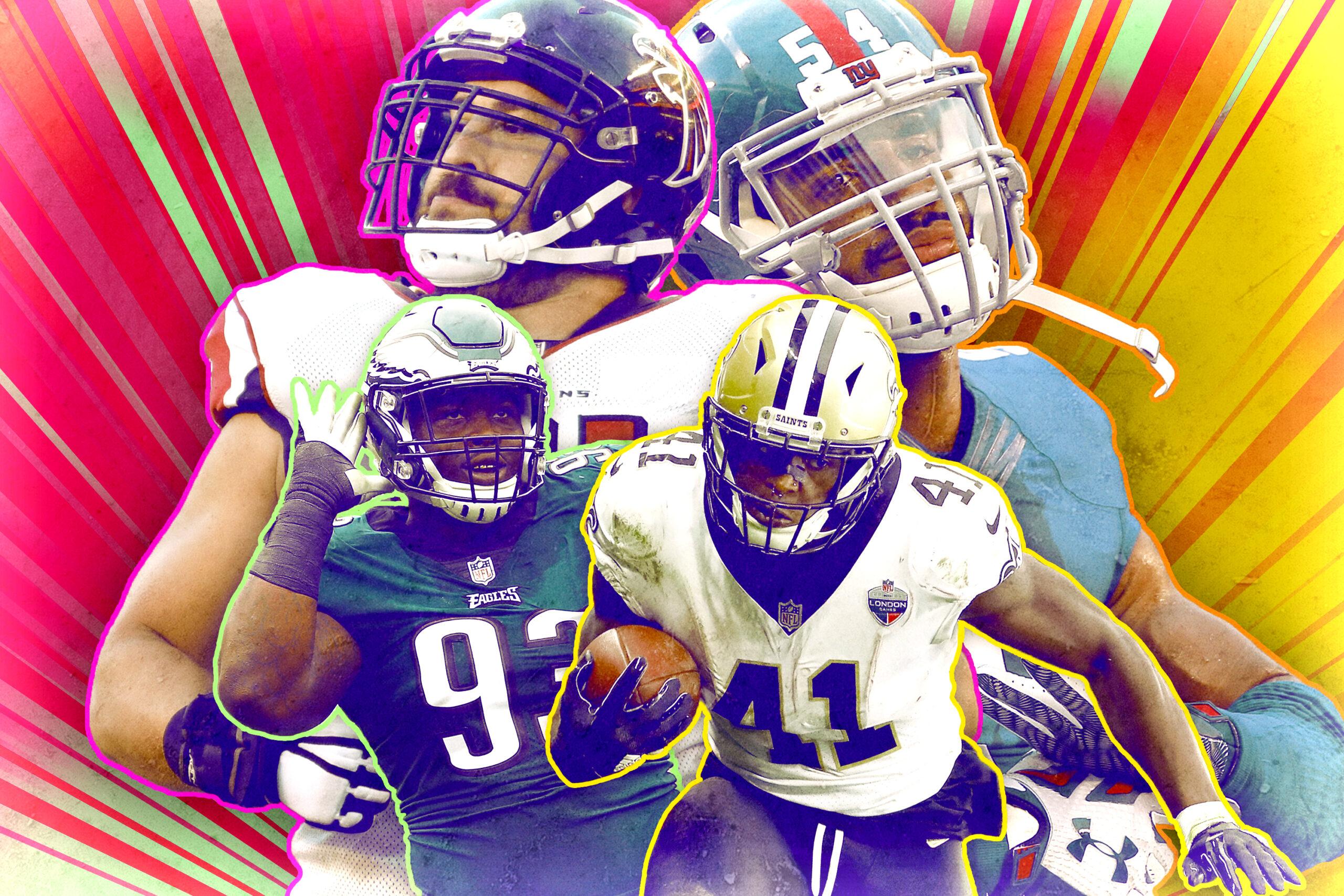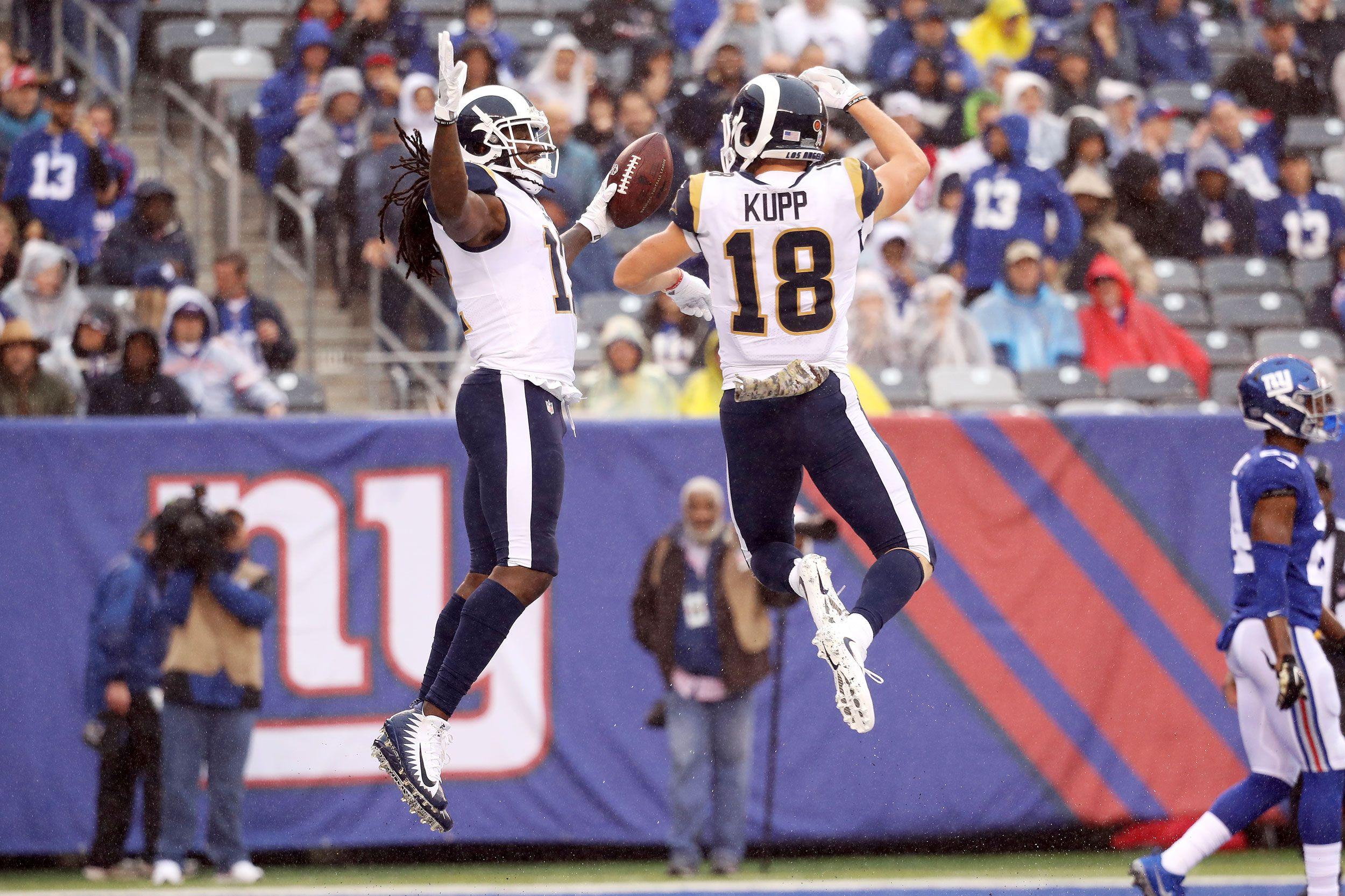
In last Sunday’s 30-10 win over the Buccaneers, Saints running back Alvin Kamara found the end zone twice, including on a dazzling catch-and-run in the second quarter. In a 51-17 rout of the Giants, Rams wide receiver Robert Woods scored two touchdowns, one of which was a 52-yarder that came on a third-and-33. And in a 23-7 victory over the Bengals, Jaguars defensive end Calais Campbell collected his league-leading 11th sack. Beyond all playing for unlikely NFL contenders, these three guys share another common trait: They’re each on teams they weren’t with a season ago.
The prevalence of such players is part of a larger trend that’s defined the 2017 campaign. A huge portion of the teams near the top of the standings underwent substantial renovations this spring. Of the 12 clubs that would make the playoffs if the regular season ended today, half feature at least five new starters who were acquired through the draft, trades, or free agency this offseason. While that may not seem like a big number at a glance, it’s huge by historical NFL standards. In 2010, the average number of first-year starters on the 12 playoff teams was 2.92. If the 2017 standings were to hold, it would be 4.33. That amounts to almost 20 percent of a team’s offensive and defensive starting lineup.
The growing impact of first-year starters on contenders became apparent last season, when teams like the Falcons, Giants, and Raiders rode them to unforeseen heights. Atlanta’s additions of center Alex Mack and receiver Mohamed Sanu helped propel its offense to historic levels, and its influx of rookie defensive talent (Deion Jones, De’Vondre Campbell, and Keanu Neal) injected life into a unit that only got better down the stretch. The NFC champions featured seven first-year starters in all, tied for the most among playoff teams in that conference. They were matched by the Giants, who used the offseason acquisitions of Olivier Vernon, Janoris Jenkins, and Damon Harrison to jump-start a defense that finished 30th in Football Outsiders’ DVOA the year before and turn it into the second-ranked group in the league.
For years, the draft-and-develop model of team-building was treated like a sacred text. The mad scramble to hand out big-money free-agent deals was considered a fool’s errand, and rookies were rarely seen as day-one difference-makers. If the past two seasons have taught us anything about the modern NFL, though, it’s that this belief no longer holds true. From the team-building incentives driven by the current CBA to the newfound parity across the league, a host of factors has led more teams to redo their rosters on the fly—and push themselves toward the postseason as a result.
Welcome to the era of the face-lift NFL contender: The right combination of moves can elevate a team from the dregs of mediocrity to legit Super Bowl contention in a single offseason.
The age of NFL players is on the decline. Many writers, most notably The Ringer’s own Kevin Clark, have explored this phenomenon in depth and explained the effects that it’s had across the sport as a whole. Last month, longtime NFL columnist Rick Gosselin noted that the average age of the league’s starters was 26.7 years old, down from 27.4 in 2007, and that there were only 239 players age 30 or older on opening-day rosters. That’s 106 fewer than there were a decade ago.
Under the current CBA, cost-controlled rookie contracts have incentivized teams to stockpile players on rookie deals and eschew aging veterans. The result has been a significant uptick in the number of rookies who get early playing time, and in 2017 we’ve been able to glean what sort of impact a talent-laden rookie class can provide.
No team has functioned as a case study in rookie production quite like the Saints, who’ve leaned heavily on their newbies during a 6-2 start that has lifted them to first place in the NFC South. New Orleans entered this year’s draft with two first-round picks after dealing receiver Brandin Cooks to New England for the 31st overall selection, and by completing a draft-day deal with the 49ers to secure an additional third-rounder (no. 67 overall), the franchise suddenly had five picks in the top 76. Four of the players taken with those picks—cornerback Marshon Lattimore, tackle Ryan Ramczyk, safety Marcus Williams, and linebacker Alex Anzalone—were in the Saints’ starting lineup in Week 1. The fifth was Kamara, who’s casually gone on pace to rack up 1,300 yards from scrimmage and double-digit touchdowns. “The significance of the draft class can’t be overstated,” head coach Sean Payton told The MMQB’s Peter King when discussing his team’s hot start on Sunday night. “It’s made all the difference.”
That’s been especially clear with the New Orleans defense. In a single season, Lattimore and Williams have helped the Saints go from being a league-wide laughingstock to ranking eighth (!) in defensive DVOA. Lattimore has looked like one of the best cover corners in the NFL from the moment he stepped onto the field, and Williams has given this group its most reliable center-field defender in years. With four new starters (five counting Anzalone, who’s on IR with an elbow injury), the Saints defense has been remade. And the players most responsible may be two first-year defensive backs who probably wouldn’t have seen significant action had they come into the league five years ago instead of now.
If New Orleans has shown how quickly a rookie class can transform a team’s success on one side of the ball, then Jacksonville has proved how a single draft pick can alter a franchise’s identity. When the Jags selected LSU running back Leonard Fournette fourth overall in April, it was a sign that this team wanted to grind its opponents into dust under first-year head coach Doug Marrone. After finishing 26th in rushing percentage (running on 36.7 percent of their offensive snaps) in 2016, the Jags are rushing a league-high 52.5 percent of the time this fall. Fournette has averaged 4.6 yards per attempt despite facing eight or more defenders in the box on 49.2 percent of snaps, the third-highest rate in the league. He has willed this ground game to prominence all on his own, and he’s given Jacksonville an offensive presence to pair with the league’s best defense.
With more rookies seeing the field than ever before, the importance of a front office hitting on an incoming draft class has massive implications. Fournette, Lattimore, Kareem Hunt, Dalvin Cook, and Deshaun Watson all represent telling examples of how young guys are determining who wins and loses in the league’s modern landscape. If a team truly wants to take the express from the basement to the penthouse, though, it needs to blend an instant-impact rookie haul with a crop of game-changing veteran acquisitions. That’s the blueprint Atlanta used in its run to a Super Bowl berth last season, and it’s one that a handful of unexpected contenders have replicated in their stunning surges this fall.

Among this year’s face-lift contenders, no teams have more new veteran starters than the Rams (six) and Eagles (five). The Los Angeles offense looks completely rejuvenated with two new stalwarts on the line (Andrew Whitworth and John Sullivan) and a revamped stable of receivers (that includes Woods and Sammy Watkins). And the gains that unit has made in a single year are nothing short of remarkable. After finishing dead last in offensive DVOA last season, L.A. ranks ninth through the end of Week 9. A huge chunk of the credit for that turnaround goes to first-year head coach Sean McVay, but what’s occasionally been lost in the McVay and Jared Goff hysteria is that the offense’s personnel is almost totally new. That’s evident with rookies like receiver Cooper Kupp (370 yards, three scores) and stars like Watkins (who reeled in a 67-yard touchdown last weekend).
Philadelphia wasn’t in need of a complete overhaul on either side of the ball this offseason, but the tweaks the Eagles made have played a critical role in fueling their league-best 8-1 start. In signing Alshon Jeffery to a one-year, $9.5 million deal, plucking cornerback Patrick Robinson off the scrap heap, and trading the equivalent of a sixth-round pick to steal defensive tackle Timmy Jernigan away from the Ravens, the Eagles were able to fill out the edges of their roster with a series of low-risk moves. In years past, this type of roster construction might have been frowned upon; neither Jeffery nor Jernigan remains under contract in Philly beyond this season. Yet in a climate where parity reigns, adding even a single year of high-end veteran talent can shake up the conference hierarchy.
Parity has been a theme in the NFL of late, as the league has a shortage of dominant teams and a burgeoning middle class. With teams both creeping closer together in the standings and growing more consistent, a franchise can stand to make a huge jump with a collection of the right incremental moves. That may be the biggest reason the 2017 NFL trade deadline was so wildly active.
It’s also why the number of first-year starters on postseason teams has increased over the past seven years, by about 1.4 players per team since 2010. There are a few exceptions to this trend—the average number of first-year starters on 2013 playoff teams was 4.25, due in large part to the Colts featuring eight veteran additions (including Trent Richardson, LaRon Landry, and Gosder Cherilus)—but nothing about the tenure of former Indianapolis general manager Ryan Grigson should count. Most of this year’s playoff hopefuls have thrived because of the offseason deals they made; those Andrew Luck–led Colts got to the postseason in spite of them.
And one of the key differences with overhauled playoff (and would-be playoff) teams over the past two seasons is where they fall in the NFL power structure. In years past, the teams that turned over a significant portion of their starting lineup and snuck into the postseason were bounced quickly. They were wild-card winners and little more. In 2016 and 2017, though, these revamped rosters have developed into real Super Bowl threats. The Eagles now have 4-1 odds to go all the way, according to Vegas, putting them behind only the Patriots. Surveying the rest of the league, Philly felt that getting one year of players like Jeffery and Jernigan was worth it; right now, that logic looks like it could pay off in a big way.
Outside factors like coaching changes, schematic tweaks, and the progress made by young stars such as quarterback Carson Wentz have all played an undeniable role in the Eagles’ success, but the team’s series of less-heralded offseason moves has allowed them to tie everything together on both sides of the ball. And given the reverberations those types of moves can make, expect a growing number of franchises to enter each spring with cause for hope—and the inspiration to make to a major splash in free agency.